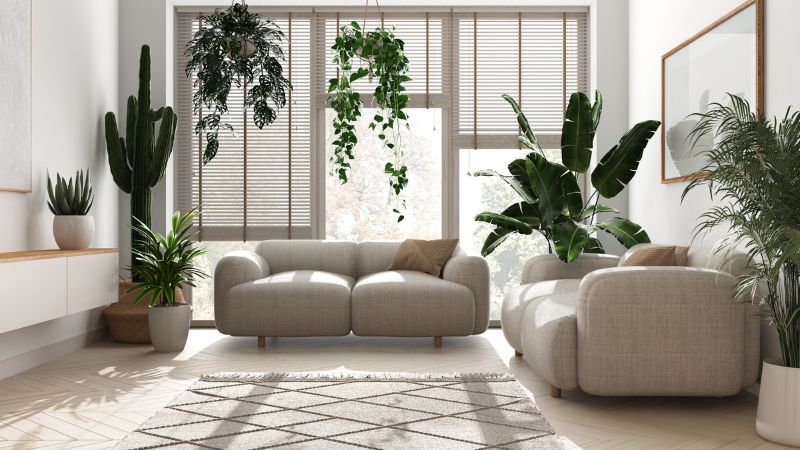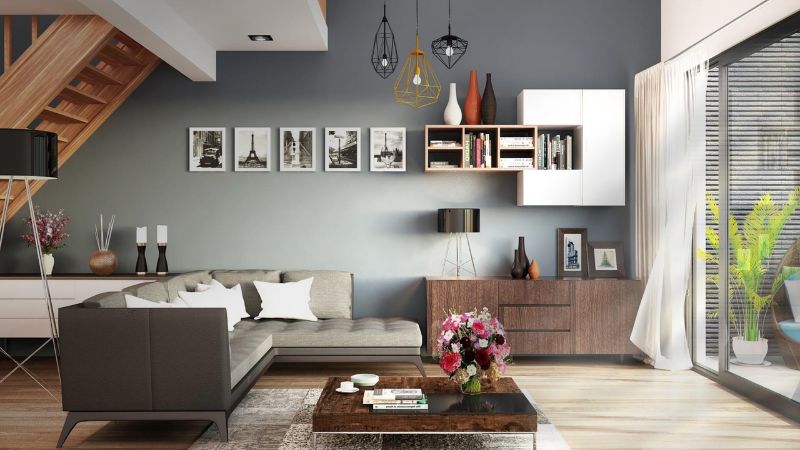Incorporating sustainable practices into interior design is becoming increasingly important as awareness of environmental issues grows. Sustainable interior design not only reduces the environmental impact of your home but also enhances the quality of life by promoting healthier living spaces. By integrating eco-friendly materials, energy-efficient solutions, and waste-reducing strategies, you can create a stylish and comfortable home while supporting the planet. This guide explores eleven innovative and practical sustainable interior design ideas that can help you achieve an eco-friendly home. From using reclaimed materials to choosing energy-efficient appliances, these ideas will guide you in making more sustainable choices for your living space.
Sustainable Interior Design Ideas
1. Utilize Reclaimed and Upcycled Materials

Incorporating reclaimed and upcycled materials into your home design is a key aspect of sustainable interior design. Reclaimed materials, such as salvaged wood, metal, or bricks, give new life to previously used items, reducing the demand for new resources. By “upcycling,” we mean repurposing previously used materials into something fresh and useful. For example, old barn wood can be repurposed into stylish furniture or wall panels. Using these materials not only prevents waste but also adds unique character and charm to your home. Embracing reclaimed and upcycled materials in your sustainable interior design helps conserve natural resources and promotes a circular economy.
2. Choose Eco-Friendly Flooring Options
When selecting flooring, opt for eco-friendly materials that minimize environmental impact. Bamboo and cork are excellent choices due to their rapid renewability and low environmental footprint. Bamboo grows quickly and requires minimal pesticides, making it a sustainable alternative to traditional hardwood. Cork, harvested from the bark of cork oak trees, is biodegradable and has natural antimicrobial properties. Additionally, consider recycled-content flooring like rubber tiles made from recycled tires or reclaimed wood flooring for a unique look. These sustainable flooring options not only reduce your home’s carbon footprint but also offer durability and style.
3. Implement Energy-Efficient Lighting Solutions
Energy-efficient lighting is a fundamental component of sustainable interior design. Switching to LED bulbs, which use up to 75% less energy than incandescent bulbs, can significantly reduce your home’s energy consumption. Because LED lights last longer, you won’t have to buy as many replacements and produce less trash. Additionally, consider installing dimmer switches and motion sensors to further enhance energy efficiency. Utilizing natural light through strategically placed windows and skylights can also reduce reliance on artificial lighting. By choosing energy-efficient lighting solutions, you contribute to a lower carbon footprint and create a more eco-friendly home.
4. Incorporate Low-VOC Paints and Finishes
Volatile organic compounds (VOCs) are chemicals found in many paints and finishes that can negatively impact indoor air quality. Choosing low-VOC or zero-VOC paints and finishes is crucial for maintaining a healthy and sustainable interior environment. These eco-friendly options release fewer toxins into the air, reducing respiratory issues and promoting better indoor air quality. Additionally, low-VOC products are often made from natural ingredients and have a smaller environmental footprint. By opting for low-VOC paints and finishes, you enhance the sustainability of your home while ensuring a healthier living space.
Read Also: Principles Of Minimalist Interior Design
5. Invest in Energy-Efficient Appliances
Energy-efficient appliances play a significant role in sustainable interior design by reducing energy consumption and minimizing utility bills. Appliances that have earned the ENERGY STAR® designation have shown that they are up to the challenge of meeting the rigorous energy efficiency standards established by the EPA in the United States. Energy-efficient refrigerators, dishwashers, washing machines, and ovens use less energy and water compared to standard models. Additionally, consider smart appliances that allow for remote control and energy monitoring. Investing in energy-efficient appliances not only supports a more sustainable home but also contributes to long-term savings and reduced environmental impact.
6. Opt for Sustainable Furniture Choices

Sustainable furniture choices are essential for creating an eco-friendly home. When selecting furniture, look for pieces made from renewable or reclaimed materials, such as FSC-certified wood or bamboo. Opt for products that use non-toxic finishes and adhesives to ensure a healthier indoor environment. Additionally, consider investing in high-quality, timeless designs that will last longer and reduce the need for frequent replacements. Supporting companies that prioritize sustainability and ethical practices further enhances the eco-friendliness of your interior design. By making thoughtful furniture choices, you contribute to a more sustainable and stylish home.
7. Use Natural and Organic Fabrics
Incorporating natural and organic fabrics into your home design is an excellent way to promote sustainability. Fabrics made from organic cotton, linen, wool, and hemp are produced without harmful pesticides and chemicals, making them better for the environment and your health. These materials are often biodegradable and have a lower environmental impact compared to synthetic fabrics. Additionally, look for certifications such as Global Organic Textile Standard (GOTS) to ensure that the fabrics meet rigorous sustainability criteria. By choosing natural and organic fabrics for upholstery, curtains, and bedding, you enhance the comfort and eco-friendliness of your home.
8. Embrace Water-Efficient Fixtures
Water-efficient fixtures are an important aspect of sustainable interior design, helping to conserve water and reduce utility costs. Installing low-flow faucets, showerheads, and toilets can significantly decrease water consumption without compromising performance. Look for fixtures with WaterSense® labels, which indicate that they meet water efficiency and performance criteria set by the Environmental Protection Agency. Additionally, consider incorporating water-saving technologies, such as rainwater harvesting systems or greywater recycling, to further enhance water conservation efforts. By embracing water-efficient fixtures, you contribute to a more sustainable home and help preserve this vital resource.
9. Integrate Indoor Plants for Air Quality
Indoor plants not only add beauty to your home but also play a crucial role in improving air quality. Plants such as spider plants, peace lilies, and snake plants help filter out toxins and pollutants from the air, creating a healthier living environment. They also contribute to increased humidity, which can be beneficial for respiratory health. Integrating indoor plants into your sustainable interior design enhances both aesthetics and air quality. Consider placing plants in various rooms and choosing low-maintenance varieties to ensure they thrive and contribute to a greener, more eco-friendly home.
10. Optimize Home Insulation
Proper insulation is essential for maintaining energy efficiency and comfort in a sustainable interior design. Good insulation helps regulate indoor temperatures, reducing the need for heating and cooling and minimizing energy consumption. Opt for eco-friendly insulation materials, such as recycled cellulose or sheep’s wool, which have lower environmental impacts compared to traditional options. Additionally, ensure that windows and doors are well-sealed to prevent drafts and heat loss. By optimizing home insulation, you enhance energy efficiency, reduce utility costs, and contribute to a more sustainable living environment.
11. Focus on Sustainable Window Treatments

Sustainable window treatments can significantly impact the eco-friendliness of your home. Choose window coverings made from natural or recycled materials, such as bamboo shades or organic cotton curtains. In many cases, these materials outperform synthetic alternatives in terms of sustainability and environmental friendliness. Additionally, consider installing energy-efficient window treatments, such as cellular shades or thermal curtains, which help regulate indoor temperatures and reduce energy consumption. Sustainable window treatments not only enhance the aesthetics of your home but also contribute to improved energy efficiency and environmental sustainability.
Read Also: Tips For Decorating a Small Apartment
Conclusion
Embracing sustainable interior design ideas is a powerful way to create an eco-friendly home while promoting environmental responsibility. From using reclaimed materials and energy-efficient lighting to opting for natural fabrics and water-efficient fixtures, each sustainable choice contributes to a healthier, more sustainable living space. You may improve your quality of life while also lowering your impact on the environment by applying these principles to your own house. Sustainable interior design is not just about aesthetics; it’s about making conscious choices that benefit both your home and the planet. Embrace these sustainable practices and enjoy the rewards of a beautifully designed, eco-friendly home.
FAQs
What are the benefits of using reclaimed materials in interior design?
You can give your house a one-of-a-kind look while also reducing waste and conserving resources by using reclaimed materials. They also minimize the environmental impact associated with new material production, making them a sustainable choice for eco-friendly interior design.
How can I improve the energy efficiency of my home with sustainable interior design?
A combination of energy-efficient equipment, better insulation, and more natural light may significantly increase a building’s energy efficiency. These measures reduce energy consumption, lower utility bills, and contribute to a more sustainable home.
Are natural and organic fabrics better for sustainable interior design?
Yes, natural and organic fabrics are better for sustainable interior design as they are produced without harmful chemicals and pesticides. They are biodegradable and have a lower environmental impact, promoting a healthier living space.


